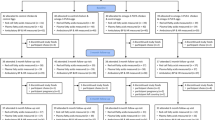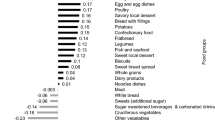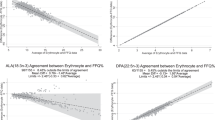Abstract
Background/Objectives:
The omega-3 index (the summed percentage content of eicosapentaenoic and docosahexaenoic acids in red blood cells) is associated with a lower risk of fatal coronary heart disease and sudden cardiac death. We aimed to determine which socio-demographic, behavioural or clinical factors are independently associated with the omega-3 index and the extent to which seafood consumption mediates the index’s association with socio-economic status (SES).
Subjects/Methods:
As part of the cross-sectional MONA LISA-NUT survey (2005–2007), gas chromatography was used to analyse the red blood cell fatty acid composition in 503 French subjects aged 35–64 years. Dietary data were collected by trained dieticians via a validated food frequency questionnaire and a prospective 3-day food record. Risk factors were estimated with standardised measurements and questionnaires. SES was assessed through the self-reported educational and income tax levels.
Results:
The mean±s.d. omega-3 index was 6.02±1.75%. In the best parsimonious predictive model (which explained 32% of the variability in the omega-3 index), age, educational level and seafood servings were significantly and positively associated with the index. In contrast, waist circumference and smoking were inversely associated with the index. In a mediation analysis that took account of all these factors, seafood servings explained about 40% of the association between educational level and the omega-3 index. Similar results were obtained for the income tax level.
Conclusions:
The inverse association between SES and omega-3 index is largely explained (40%) by an insufficient seafood intake. It remains to be seen which other factors mediate this association.
This is a preview of subscription content, access via your institution
Access options
Subscribe to this journal
Receive 12 print issues and online access
$259.00 per year
only $21.58 per issue
Buy this article
- Purchase on Springer Link
- Instant access to full article PDF
Prices may be subject to local taxes which are calculated during checkout

Similar content being viewed by others
References
Raatz SK, Silverstein JT, Jahns L, Picklo MJ . Issues of fish consumption for cardiovascular disease risk reduction. Nutrients 2013; 5: 1081–1097.
Albert CM, Campos H, Stampfer MJ, Ridker PM, Manson JE, Willett WC et al. Blood levels of long-chain n-3 fatty acids and the risk of sudden death. N Engl J Med 2002; 346: 1113–1118.
Sun Q, Ma J, Campos H, Hankinson SE, Hu FB . Comparison between plasma and erythrocyte fatty acid content as biomarkers of fatty acid intake in US women. Am J Clin Nutr 2007; 86: 74–81.
Harris WS, Thomas RM . Biological variability of blood omega-3 biomarkers. Clin Biochem 2010; 43: 338–340.
Harris WS, Sands SA, Windsor SL, Ali HA, Stevens TL, Magalski A et al. Omega-3 fatty acid levels in transplanted human hearts: effect of supplementation and comparison with erythrocytes. Circulation 2004; 110: 1645–1649.
Harris WS, von Schacky C . The omega-3 index: a new risk factor for death from coronary heart disease? Prev Med 2004; 39: 212–220.
Von Schacky C . Omega-3 index and cardiovascular health. Nutrients 2014; 6: 799–814.
Sala-Vila A, Harris WS, Cofan M, Perez-Heras AM, Pinto X, Lamuela-Raventos RM et al. Determinants of the omega-3 index in a Mediterranean population at increased risk for CHD. Br J Nutr 2011; 106: 425–431.
Itomura M, Fujioka S, Hamazaki K, Kobayashi K, Nagasawa T, Sawazaki S et al. Factors influencing EPA+DHA levels in red blood cells in Japan. In vivo 2008; 22: 131–136.
Sands SA, Reid KJ, Windsor SL, Harris WS . The impact of age, body mass index, and fish intake on the EPA and DHA content of human erythrocytes. Lipids 2005; 40: 343–347.
Cohen BE, Garg SK, Ali S, Harris WS, Whooley MA . Red blood cell docosahexaenoic acid and eicosapentaenoic acid concentrations are positively associated with socio-economic status in patients with established coronary artery disease: data from the Heart and Soul Study. J Nutr 2008; 138: 1135–1140.
Harris WS, Pottala JV, Lacey SM, Vasan RS, Larson MG, Robins SJ . Clinical correlates and heritability of erythrocyte eicosapentaenoic and docosahexaenoic acid content in the Framingham Heart Study. Atherosclerosis 2012; 225: 425–431.
Block RC, Harris WS, Pottala JV . Determinants of blood cell omega-3 fatty acid content. Open Biomark J 2008; 1: 1–6.
Salisbury AC, Amin AP, Harris WS, Chan PS, Gosch KL, Rich MW et al. Predictors of omega-3 index in patients with acute myocardial infarction. Mayo Clin Proc 2011; 86: 626–632.
Kuulasmaa K, Tunstall-Pedoe H, Dobson A, Fortmann S, Sans S, Tolonen H et al. Estimation of contribution of changes in classic risk factors to trends in coronary-event rates across the WHO MONICA Project populations. Lancet 2000; 355: 675–687.
Cottel D, Dallongeville J, Wagner A, Ruidavets JB, Arveiler D, Ferrières J et al. The North-East-South gradient of coronary heart disease mortality and case fatality rates in France is consistent with a similar gradient in risk factor clusters. Eur J Epidemiol 2000; 16: 317–322.
Wagner A, Sadoun A, Dallongeville J, Ferrières J, Amouyel P, Ruidavets JB et al. High blood pressure and control in a middle-aged French population and their associated factors: the MONA LISA study. J Hypertens 2011; 29: 43–50.
Pigeyre M, Dauchet L, Simon C, Bongard V, Bingham A, Arveiler D et al. Effects of occupational and educational changes on obesity trends in France: the results of the MONICA-France survey 1986-2006. Prev Med 2011; 52: 305–309.
WHO MONICA Project MONICA Manual (1998-1999). Part III: population survey. Section I: population survey data component (December 1997). Available from http://www.thl.fi/publications/monica/manual/part3/iii-1.htm.
International Center for Alcohol Policies (December 2003). Reports 14. International drinking guidelines. http://www.icap.org/Publications/ICAPReports.
Knuiman J, Pietinen P, De Backer G, Ducimetière E . The MONICA-Project: Optional Study on the Surveillance of Dietary Intake of the Population With Regard to Cardiovascular Diseases Manual of Operations. EURONUT Report 6. The Netherlands: EURONUT, 1985.
SU.VI.MAX-Candia/polytechnica. Portions alimentaires: manuel-photos pour l’estimation des quantités. Candia: Economica, 2002.
Giovannelli J, Dallongeville J, Wagner A, Bongard V, Laillet B, Marecaux N et al. Validation of a short, qualitative food frequency questionnaire in French adults participating in the MONA LISA-NUT study 2005-2007. J Acad Nutr Diet 2014; 114: 552–561.
Folch J, Lees M, Sloane Stanley GH . A simple method for the isolation and purification of total lipides from animal tissues. J Biol Chem 1957; 26: 497–509.
Tardy AL, Lambert-Porcheron S, Malpuech-Brugère C, Giraudet C, Rigaudière JP, Laillet B et al. Dairy and industrial sources of trans fat do not impair peripheral insulin sensitivity in overweight women. Am J Clin Nutr 2009; 90: 88–94.
Willett WC, Howe GR, Kushi LH . Adjustment for total energy intake in epidemiologic studies. Am J Clin Nutr 1997; 65: 1220S–1228S.
Baron RM, Kenny DA . The moderator-mediator variable distinction in social psychological research: conceptual, strategic, and statistical considerations. J Pers Soc Psychol 1986; 51: 1173–1182.
Krause MR, Serlin RC, Ward SE, Rony RY, Ezenwa MO, Naab F . Testing mediation in nursing research: beyond Baron and Kenny. Nurs Res 2010; 59: 288–294.
Efron B . Bootstrap methods: another look at the Jackknife. Ann Stat 1979; 7: 1–26.
Ebbesson SO, Devereux RB, Cole S, Ebbesson LO, Fabsitz RR, Haack K et al. Heart rate is associated with red blood cell fatty acid concentrations: The Genetics of coronary artery disease in Alaska Natives (GOCADAN) study. Am Heart J 2010; 159: 1020–1025.
de Groot RH, van Boxtel MP, Schiepers OJ, Hornstra G, Jolles J . Age dependence of plasma phospholipid fatty acid levels: potential role of linoleic acid in the age-associated increase in docosahexaenoic acid and eicosapentaenoic acid concentrations. Br J Nutr 2009; 102: 1058–1064.
Ogura T, Takada H, Okuno M, Kitade H, Matsuura T, Kwon M et al. Fatty acid composition of plasma, erythrocytes and adipose: their correlates and effects of age and sex. Lipids 2010; 45: 137–144.
Decsi T, Kennedy K . Sex-specific differences in essential fatty acid metabolism. Am J Clin Nutr 2011; 94 (6 Suppl): 1914S–1919S.
Childs CE, Romeu-Nadal M, Burdge GC, Calder PC . Gender differences in the n-3 fatty acid content of tissues. Proc Nutr Soc 2008; 67: 19–27.
di Guiseppe R, de Lorgeril M, Salen P, Laporte F, Di Castelnuovo A, Krogh V . European collaborative group of the IMMIDIET Project. Alcohol consumption and n-3 polyunsaturated fatty acids in healthy men and women from 3 European populations. Am J Clin Nutr 2009; 89: 354–362.
Cazzola R, Rondanelli M, Russo-Volpe S, Ferrari E, Cestaro B . Decreased membrane fluidity and altered susceptibility to peroxydation and lipid composition in overweight and obese female erythrocytes. J Lipid Res 2004; 45: 1846–1851.
Wang Y, Botolin D, Xu J, Christian B, Mitchell E, Jayaprakasam B et al. Regulation of hepatic fatty acid elongase and desaturase expression in diabetes and obesity. J Lipid Res 2006; 47: 2028–2041.
Hibbeln JR, Makino KK, Martin CE, Dickerson F, Boronow J, Fenton WS . Smoking, gender, and dietary influences on erythrocytes essential fatty acid composition among patients with schizophrenia or schizoaffective disorder. Biol Psychiatry 2003; 53: 431–441.
Hsiao HM, Sapinoro RE, Thatcher TH, Croasdell A, Levy EP, Fulton RA et al. A novel anti-inflammatory and pro-resolving role for resolving D1 in acute cigarette smoke-induced lung inflammation. PLoS One 2013; 8: e58258.
AFSSA (2009) Rapport de l’étude Individuelle Nationale des Consommations Alimentaires 2 (INCA2) 2006-2007. http://www.afssa.fr/Documents/PASER-Ra-INCA2.pdf.
Dickinson A, Blatman J, El-Dash N, Franco JC . Consumer usage and reasons for using dietary supplements: report of a series of surveys. J Am Coll Nutr 2014; 33: 176–182.
Acknowledgements
We would like to thank the nurses, physicians, dieticians, computer scientists and secretaries and the Centre de Médecine Préventive de Lille, the Laboratoire d’Analyses Génomiques and the Service de Biologie Spécialisée de l’Institut Pasteur de Lille, the Centre de Santé de la MGEN de Strasbourg, the Unité de Coordination de la Biologie des Essais Cliniques des Hôpitaux Universitaires de Strasbourg, the Departments of Cardiology of the Toulouse University Hospital and the Human Nutrition Unit of Clermont-Ferrand, whose technicians from the CHLEO team have carried out the GC analyses. The MONA LISA Study was made possible by an unrestricted grant of Pfizer and by a grant from ANR (ANR-05-PNRA-018). Pfizer and ANR had no role in the design, analysis or writing of this article.
Author Contributions
AW, CS, JD, JBR, DC, JF and DA designed the study or were involved in the study management; BM and BL were involved in the assessment of the fatty acid composition in red blood cell membranes; AW drafted the manuscript and performed the analyses. All authors contributed to the interpretation of the data and critically reviewed the manuscript.
Author information
Authors and Affiliations
Corresponding author
Ethics declarations
Competing interests
The authors declare no conflict of interest.
Additional information
Supplementary Information accompanies this paper on European Journal of Clinical Nutrition website
Supplementary information
Rights and permissions
About this article
Cite this article
Wagner, A., Simon, C., Morio, B. et al. Omega-3 index levels and associated factors in a middle-aged French population: the MONA LISA-NUT Study. Eur J Clin Nutr 69, 436–441 (2015). https://doi.org/10.1038/ejcn.2014.219
Received:
Revised:
Accepted:
Published:
Issue Date:
DOI: https://doi.org/10.1038/ejcn.2014.219



